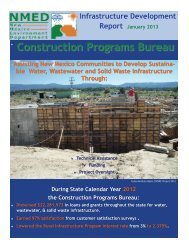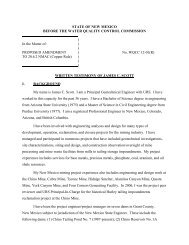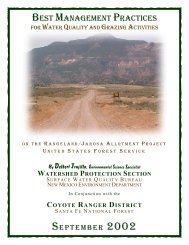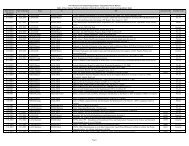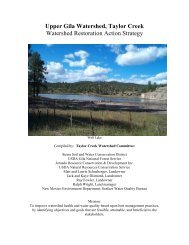Surface and Precipitation Stations - New Mexico Environment ...
Surface and Precipitation Stations - New Mexico Environment ...
Surface and Precipitation Stations - New Mexico Environment ...
Create successful ePaper yourself
Turn your PDF publications into a flip-book with our unique Google optimized e-Paper software.
1.0 Introduction<br />
1.1 Objectives<br />
Under regional haze regulations, the <strong>Environment</strong>al Protection Agency (EPA) has issued final<br />
guidelines dated July 6, 2005 for Best Available Retrofit Technology (BART) determinations (70 FR<br />
39104-39172). Sources are BART-eligible if they meet three criteria including potential emissions<br />
of at least 250 tons per year of a visibility-impairing pollutant, were put in place between August 7,<br />
1962 <strong>and</strong> August 7, 1977, <strong>and</strong> fall within one of the 26 listed source categories in the guidance. A<br />
BART engineering evaluation using five statutory factors --1) existing controls; 2) cost; 3) energy<br />
<strong>and</strong> non-air environmental impacts; 4) remaining useful life of the source; 5) degree of visibility<br />
improvement expected from the application of controls --is required for any BART-eligible source<br />
that can be reasonably expected to cause or contribute to impairment of visibility in any of the 156<br />
federal parks <strong>and</strong> wilderness (Class I) areas protected under the regional haze rule. Air quality<br />
modeling is an important tool available to the States to determine whether a source can be<br />
reasonably expected to contribute to visibility impairment in a Class I area.<br />
The object of this source-specific protocol (hereinafter referred to as the PNM Protocol) is to<br />
describe the methodologies <strong>and</strong> procedures for visibility modeling to support BART engineering<br />
analysis for Public Service Company of <strong>New</strong> <strong>Mexico</strong>’s (PNM) San Juan Generating Station (SJGS)<br />
Units 1, 2, 3, <strong>and</strong> 4. These units were identified as subject-to-BART by the State of <strong>New</strong> <strong>Mexico</strong>’s<br />
<strong>Environment</strong>al Department’s Air Quality Bureau (NMED) based on BART screening exemption<br />
modeling conducted by the Western Regional Air Partnership’s (WRAP) Regional Modeling Center<br />
(RMC). The methodologies <strong>and</strong> databases referenced in this PNM Protocol are consistent with the<br />
CALMET/CALPUFF Protocol for BART Exemption Screening Analysis for Class I Areas in the<br />
Western United States dated August 15, 2006, (hereinafter referred to as the WRAP Protocol).<br />
Furthermore, the geographic <strong>and</strong> meteorological data used in the WRAP RMC BART applicably<br />
modeling is available for use on their organization website. Therefore, for consistency these data will<br />
be used to formulate the bases for the PNM BART analysis for the SJGS. After NMED reviews <strong>and</strong><br />
approves this PNM Protocol, it will provide the basis of mutually agreed upon procedures<br />
establishing the BART modeling methodology.<br />
1-1 4/13/2007



